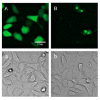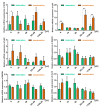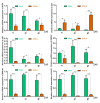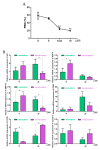Coping with DNA Double-Strand Breaks via ATM Signaling Pathway in Bovine Oocytes
- PMID: 33255251
- PMCID: PMC7727702
- DOI: 10.3390/ijms21238892
Coping with DNA Double-Strand Breaks via ATM Signaling Pathway in Bovine Oocytes
Abstract
As a common injury almost all cells face, DNA damage in oocytes-especially double-strand breaks (DSBs), which occur naturally during the first meiosis phase (meiosis I) due to synaptic complex separation-affects the fertilization ability of oocytes, instead of causing cancer (as in somatic cells). The mechanism of oocytes to effectively repair DSB damage has not yet been clearly studied, especially considering medically induced DSBs superimposed on naturally occurring DSBs in meiosis I. It was found that maturation rates decreased or increased, respectively corresponding with overexpression or interference of p21 in bovine oocytes. At the same time, the maturation rate of bovine oocytes decreased with a gradual increase in Zeocin dose, and the p21 expression in those immature oocytes changed significantly with the gradual increase in Zeocin dose (same as increased DSB intensity). Same as p21, the variation trend of ATM expression was consistent with the gradual increase in Zeocin dose. Furthermore, the oocytes demonstrated tolerance to DSBs during meiosis I, while the maturation rates decreased when the damage exceeded a certain threshold; according to which, it may be that ATM regulates the p53-p21 pathway to affect the completion of meiosis. In addition, nonhomologous recombination and cumulus cells are potentially involved in the process by which oocytes respond to DSB damage.
Keywords: ATM; DNA double-strand breaks; bovine oocyte; in vitro maturation; p21.
Conflict of interest statement
The authors declare no conflict of interest.
Figures






Similar articles
-
DNA damage response during mouse oocyte maturation.Cell Cycle. 2016;15(4):546-58. doi: 10.1080/15384101.2015.1128592. Epub 2016 Jan 8. Cell Cycle. 2016. PMID: 26745237 Free PMC article.
-
Cumulus Cells Block Oocyte Meiotic Resumption via Gap Junctions in Cumulus Oocyte Complexes Subjected to DNA Double-Strand Breaks.PLoS One. 2015 Nov 17;10(11):e0143223. doi: 10.1371/journal.pone.0143223. eCollection 2015. PLoS One. 2015. PMID: 26575642 Free PMC article.
-
Different fates of oocytes with DNA double-strand breaks in vitro and in vivo.Cell Cycle. 2014;13(17):2674-80. doi: 10.4161/15384101.2015.945375. Cell Cycle. 2014. PMID: 25486355 Free PMC article.
-
BRCA-related ATM-mediated DNA double-strand break repair and ovarian aging.Hum Reprod Update. 2020 Jan 1;26(1):43-57. doi: 10.1093/humupd/dmz043. Hum Reprod Update. 2020. PMID: 31822904 Free PMC article. Review.
-
The influence of heterochromatin on DNA double strand break repair: Getting the strong, silent type to relax.DNA Repair (Amst). 2010 Dec 10;9(12):1273-82. doi: 10.1016/j.dnarep.2010.09.013. Epub 2010 Oct 30. DNA Repair (Amst). 2010. PMID: 21036673 Review.
Cited by
-
DNA Double-Strand Break-Related Competitive Endogenous RNA Network of Noncoding RNA in Bovine Cumulus Cells.Genes (Basel). 2023 Jan 22;14(2):290. doi: 10.3390/genes14020290. Genes (Basel). 2023. PMID: 36833217 Free PMC article.
-
miR-302d Targeting of CDKN1A Regulates DNA Damage and Steroid Hormone Secretion in Bovine Cumulus Cells.Genes (Basel). 2023 Dec 10;14(12):2195. doi: 10.3390/genes14122195. Genes (Basel). 2023. PMID: 38137018 Free PMC article.
-
cAMP Modulators before In Vitro Maturation Decrease DNA Damage and Boost Developmental Potential of Sheep Oocytes.Animals (Basel). 2021 Aug 26;11(9):2512. doi: 10.3390/ani11092512. Animals (Basel). 2021. PMID: 34573478 Free PMC article.
References
-
- Madaschi C., Aoki T., de Almeida Ferreira Braga D.P., de Cássia Sávio Figueira R., Francisco L.S., Iaconelli A., Jr., Borges E., Jr. Zona pellucida birefringence score and meiotic spindle visualization in relation to embryo development and ICSI outcomes. Reprod. Biomed. Online. 2009;18:681–686. doi: 10.1016/S1472-6483(10)60014-4. - DOI - PubMed
MeSH terms
Substances
LinkOut - more resources
Full Text Sources
Research Materials
Miscellaneous

